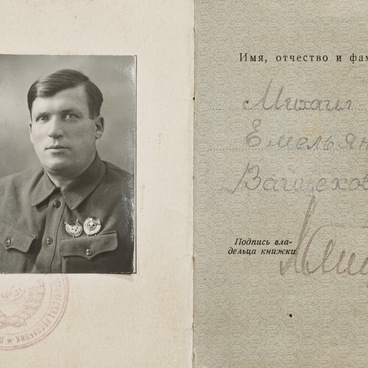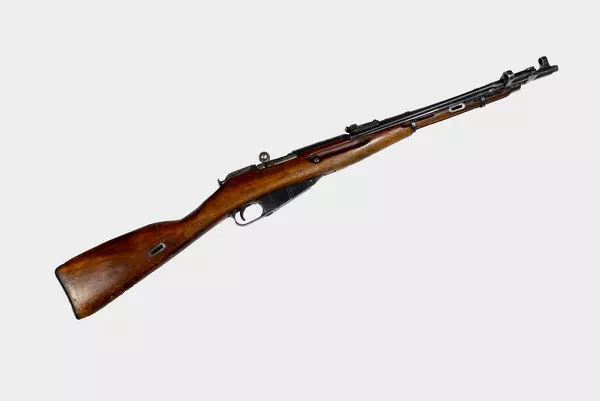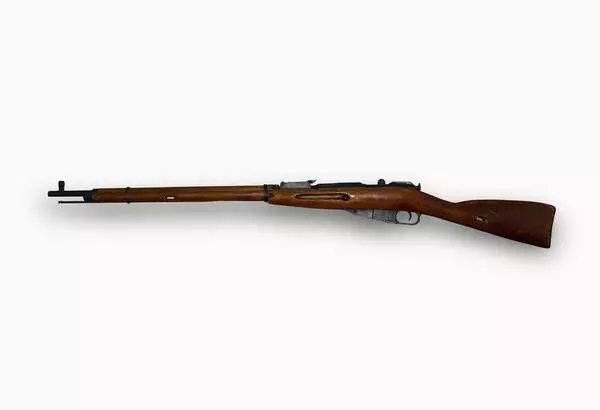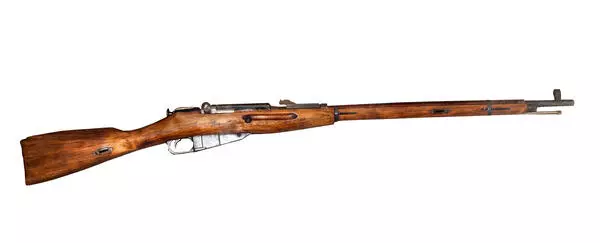The rifle presented in the exhibition was designed by Captain of the Russian army Sergei Ivanovich Mosin.
In 1883, Mosin designed his first magazine-fed rifles. He improved the Berdan rifle by attaching an eight-round magazine to it. On April 16, 1891, a prototype of a “repeating” rifle with a fixed magazine of the three-line-caliber was approved (a line is an obsolete unit of measurement, three lines are equal to 7.62 millimeters). Its complete cycle of operation included four steps. It was mainly based on Mosin’s design and designated as the “3-line rifle of the 1891 model.”
In addition to the standard rifle intended for infantry soldiers, variants for Dragoon and Cossack units were also produced — those had a shorter barrel. In 1907, a carbine version was put into production. This type was used by soldiers of special forces and auxiliary units.
The 7.62mm rifle of the 1891 model is a magazine-fed rifle with a rotating bolt that uses symmetrical locking lugs on the bolt head.
The rifle was modernized for the first time in 1910 as the Russian army had adopted in 1908 a new 7.62mm cartridge with a pointed bullet that had improved ballistics. The modernization consisted mainly in the introduction of a new sight mount.
In 1930, the Dragoon rifle underwent a more thorough redevelopment. In 1922, it became the main weapon of the Red Army’s rifle units. New iron sights with crosshairs were fitted on it, the design of the front sight was changed and new snap rings were introduced to attach the barrel to the buttstock in a more reliable way. The way of fixing the spike bayonet was also changed. This rifle was put into mass production and was in service with the Red Army prior to and during the Second World War.
Before the war, large batches of 7.62mm rifles of the 1891/1930 model were sent to the Second Spanish Republic. 500,000 rifles and 862 million rounds of ammunition were delivered as well. Even more rifles were sent to China.
The 1891/30 model was distinguished by high reliability, accuracy, simplicity and ease of operation. It consisted of only 42 parts compared to 70 or more in other rifles, which facilitated its mass production. In total, more than 12 million rifles of the 1891/1930 model and carbines developed from this model were manufactured during the war years.
In 1883, Mosin designed his first magazine-fed rifles. He improved the Berdan rifle by attaching an eight-round magazine to it. On April 16, 1891, a prototype of a “repeating” rifle with a fixed magazine of the three-line-caliber was approved (a line is an obsolete unit of measurement, three lines are equal to 7.62 millimeters). Its complete cycle of operation included four steps. It was mainly based on Mosin’s design and designated as the “3-line rifle of the 1891 model.”
In addition to the standard rifle intended for infantry soldiers, variants for Dragoon and Cossack units were also produced — those had a shorter barrel. In 1907, a carbine version was put into production. This type was used by soldiers of special forces and auxiliary units.
The 7.62mm rifle of the 1891 model is a magazine-fed rifle with a rotating bolt that uses symmetrical locking lugs on the bolt head.
The rifle was modernized for the first time in 1910 as the Russian army had adopted in 1908 a new 7.62mm cartridge with a pointed bullet that had improved ballistics. The modernization consisted mainly in the introduction of a new sight mount.
In 1930, the Dragoon rifle underwent a more thorough redevelopment. In 1922, it became the main weapon of the Red Army’s rifle units. New iron sights with crosshairs were fitted on it, the design of the front sight was changed and new snap rings were introduced to attach the barrel to the buttstock in a more reliable way. The way of fixing the spike bayonet was also changed. This rifle was put into mass production and was in service with the Red Army prior to and during the Second World War.
Before the war, large batches of 7.62mm rifles of the 1891/1930 model were sent to the Second Spanish Republic. 500,000 rifles and 862 million rounds of ammunition were delivered as well. Even more rifles were sent to China.
The 1891/30 model was distinguished by high reliability, accuracy, simplicity and ease of operation. It consisted of only 42 parts compared to 70 or more in other rifles, which facilitated its mass production. In total, more than 12 million rifles of the 1891/1930 model and carbines developed from this model were manufactured during the war years.







